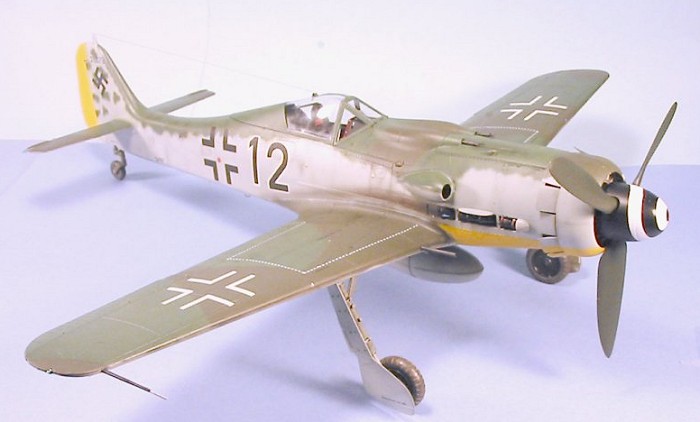
Trumpeter 1/24 FW-190D-9
| KIT #: | 2411 |
| PRICE: | $119.95 MSRP |
| DECALS: | Two options |
| REVIEWER: | Tom Cleaver |
| NOTES: |

| HISTORY |
JG 26 IN UNTERNEHMEN BODENPLATTE:
By the fall of 1944, after the air battles over France that previous summer, and with the successful conclusion of the strategic bombing campaign against the German synthetic fuel industry, the Luftwaffe was nearly a completely-spent force, with its fighter units staffed now by Nachwuchs - young pilots with less than 150 flying hours total and under 20 hours time in the high-performance fighters they were expected to fly in combat against Allied pilots who had as a minimum three times as much flying experience. Experienced formation leaders had been lost in the Battle of Germany in the Spring with the survivors of that blood-letting going down in droves over northern France.
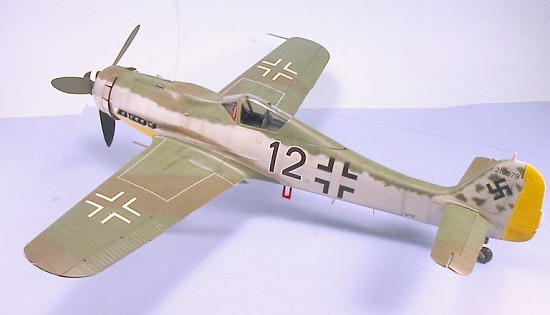 By
mid-September, JG 26 had retreated back into western Germany, where
losses were made good as far as quantity of personnel were concerned, but
certainly not with quality. In November,
II Gruppe was withdrawn
from operations to re-equip with the superlative new Focke-Wulf Fw-190D-9,
known to its pilots as the “Dora-9.” Following their success, the highly
experienced I Gruppe - which had operated the Butcher Bird in combat
longer than any other unit in the Jagdwaffe - re-equipped in the field over
the course of one week, with the unit not being taken off operations during
the process.
By
mid-September, JG 26 had retreated back into western Germany, where
losses were made good as far as quantity of personnel were concerned, but
certainly not with quality. In November,
II Gruppe was withdrawn
from operations to re-equip with the superlative new Focke-Wulf Fw-190D-9,
known to its pilots as the “Dora-9.” Following their success, the highly
experienced I Gruppe - which had operated the Butcher Bird in combat
longer than any other unit in the Jagdwaffe - re-equipped in the field over
the course of one week, with the unit not being taken off operations during
the process.
On December 16, a week after the successful completion of conversion, the weather closed in over the Western Front, limiting flying by all air forces in the region. For the Germans, this would prove particularly unfortunate, inasmuch as the newly-converted Dora pilots did not have opportunity to get to know their new mounts better. This change in the weather coincided with the commencement of the last German ground offensive in the West, which would come to be known as The Battle of the Ardennes Forest to the Germans and The Battle of the Bulge to the Americans, for whom it would be the bloodiest battle in their military history.
By Christmas Day, the weather improved sufficiently for small formation flying to recommence. III/JG 54, which had been operating as a Gruppe of JG 26 since the Normandy invasion and had been the first Jagdwaffe unit to convert to the Fw-190D-9, was caught by eight Tempest fighters of 56 Squadron and Spitfire XIVs of 411 Squadron over the Muenster basin on December 29, suffering seventeen aircraft shot down and fourteen pilots killed, which included the death of their Kommandeur, Knight’s Cross holder and 121-victory experte, Hauptman Robert “Bazi” Weiss. This was another unfortunate incident, the consequences of which would play themselves out two days later.
General Dietrich Pell, a bomber pilot who had been put in charge of all
Western Front Jagdgruppen the previous fall, had planned an
airstrike Unternehmen Bodenplatte - a low-level air strike against
Allied tactical airfields in northern France, Belgium and southern Holland
by all available units of the Jagdwaffe - to coincide with the commencement
of operations for the German ground offensive, which was called off at the
last minute by bad weather.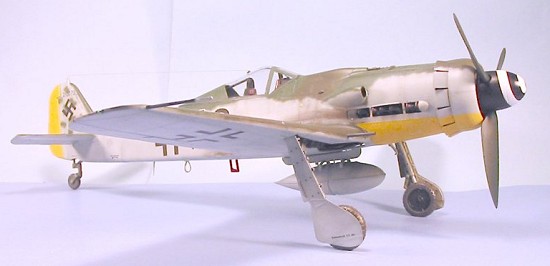
Oberst Josef “Pips” Priller, was incredulous when on the late afternoon of January 31, 1944, he received the enabling order to commence Unternehmen Bodenplatte the next day. Priller knew the strike could have no possible effect on the outcome of the now-stalled German offensive, which had in fact moved into defensive operations on Christmas Day when the weather broke and the Allied fighter bombers were turned loose on the German armored and infantry units in the Ardennes. JG 26's Kommodore, who had not flown an operational mission since the unit had returned from France and was suffering advanced combat fatigue after 5 years’ continuous combat service on the Western Front, determined that he must lead the mission. He notified his three Gruppen Kommandeuren - Major Karl Borris of I Gruppe, Major Anton Hackl of II Gruppe and Hauptmann Walter Krupinski of III Gruppe - that the Geschwader was ordered to attack the Belgian airfields at Evere and Grimbergen, both of which were fields JG 26 had flown from. Takeoff was at 0830, to hit the targets at 0930 new Year’s Day. Every healthy pilot, no matter how inexperienced, was to participate.
The 20 surviving pilots of III/JG 54 flew into Fuerstenau at last light, to fly the coming mission with Borris’ I Gruppe. Their target was Grimbergen.
The next morning, many of the Jumo 213A engines of the Dora-9s refused to start in the cold, resulting in last-minute juggling of assignments in the formation. Priller finally took off at 0832 and flew the mission with his faithful wingman, Unteroffizier Heinz Wodarczyk - with whom he had flown the legendary mission over Sword Beach on June 6. Borris led I Gruppe behind the Kommodore with III/JG 54's survivors in the rear. The pilots were told to hold close formation as they headed toward the Zuider Zee at an altitude of 100 feet - hopefully beneath the Allied radar. The planned formation of three vees could not be maintained in the ground mist and the Gruppe formation soon resolved itself as a long line of strung-out individual Schwaerme.
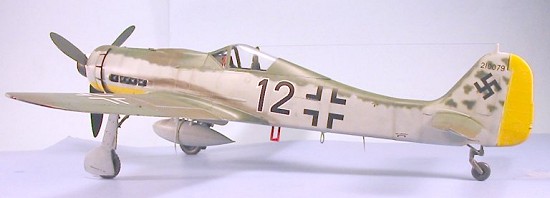 The
“meticulous planning” of the mission soon began to unravel. Over the
Zuider Zee, the formation ran into thick German
flak as their route
took them over the V-2 launching sites around the Hague - the most
heavily-defended location on the Western Front! I/JG 26 had no room to
maneuver as the flew through the curtain of fire. Coming out of the death
trap, the formation was down to 47 aircraft as 19 aircraft were missing - 5
shot down with 4 deaths and 14 shot up badly enough to force them to abort
and return to Fuerstenau. As the survivors made their turn to the south,
they were taken under fire by Allied ships in the Scheldt, losing two
pilots from III/JG 54 - one dead, one a POW.
The
“meticulous planning” of the mission soon began to unravel. Over the
Zuider Zee, the formation ran into thick German
flak as their route
took them over the V-2 launching sites around the Hague - the most
heavily-defended location on the Western Front! I/JG 26 had no room to
maneuver as the flew through the curtain of fire. Coming out of the death
trap, the formation was down to 47 aircraft as 19 aircraft were missing - 5
shot down with 4 deaths and 14 shot up badly enough to force them to abort
and return to Fuerstenau. As the survivors made their turn to the south,
they were taken under fire by Allied ships in the Scheldt, losing two
pilots from III/JG 54 - one dead, one a POW.
Just past this, Gruppe Kommandeur Borris spotted a formation of Spitfires and drifted off-course to the west as he led the evasion, not knowing that two more of his Nachwuchs in the rear of the formation were shot down by aircraft from this RAF unit.
Nearing Grimbergen, the formation climbed to 1,000 feet. Borris’ evasion had put them west of the field, forcing them to look into the rising sun to spot the target. Oberleutnant Peter Crump, Staffelfuehrer of 10 Staffel, realized they were overflying the target and led his eight aircraft into the attack. His second Schwaermfuehrer, Leutnant Theo Nibel in Schwartze-12, was shocked to see the large white cross at the end of the main runway as he roared low overhead - the international symbol of an inactive airfield!
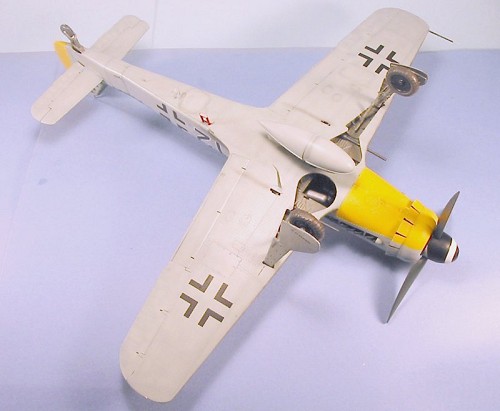 At about the
same moment, Borris realized that Priller was no longer leading the
formation, the Kommodore having turned away in the mist when the
formation ran into the German flak near the Hague. Borris took command of
the flight and turned in to the attack.
At about the
same moment, Borris realized that Priller was no longer leading the
formation, the Kommodore having turned away in the mist when the
formation ran into the German flak near the Hague. Borris took command of
the flight and turned in to the attack.
While the field was not operational, there were a few aircraft on the field, including a flak-damaged B-17 that had put down there unable to re-cross the English Channel from a mission over Germany. In the next 15 minutes I/JG 26 shot up the field thoroughly. A unit of the RAF Regiment was present on the field and put up a spirited defense, shooting down six of the attackers in the process.
Turning in on his third strafing run, Theo Nibel felt a blow that shook the entire airplane, and within a moment the temperature gauge was off the scale as the prop slowed. Nibel pulled up to an altitude of 300 feet when the engine stopped completely. Too low to bail out, Nibel bellied his Schwartze-12 onto the dirt west of the runway. His canopy was jammed in the crash, but the British soldiers smashed the plexiglass and extricated him as they put out the incipient fire in the engine. Schwartze-12 was the first intact Fw-190D-9 to fall into Allied hands.
On the return flight, four more Dora-9s fell victim to the German flak over the Zuider Zee, including Heinz Wodarczyk, Priller’s wingman, who had remained with the formation when his leader turned back.
By 1124, all the pilots who were going to return had done so. Priller was livid over the loss of 12 pilots from I Gruppe of the 48 who had taken off, but his heart bled for 12 pilots of III/JG 54 - of the 17 who had taken off that morning - who were lost in an attack against a worthless non-target.
The result of Unternehmen Bodenplatte was the nearly-complete
destruction of the Jagdwaffe as an organized force. Both
II
Gruppe and
III Gruppe of JG 26 had taken losses similar to those
suffered by I Gruppe, for the same lack of result, as had all the other
participating units. The lack of fuel supplies and the deaths of
experienced leaders over the previous twelve months, culminating in the
throwing-away of any advantages left for no worthwhile tactical or
strategic return - all Allied aircraft losses being made good within 7 days
of the event - effectively removed the Ge rman
fighter force from any meaningful role in defending the Third Reich in its
remaining four months of existence. Fighting would continue, but it would
be hopeless.
rman
fighter force from any meaningful role in defending the Third Reich in its
remaining four months of existence. Fighting would continue, but it would
be hopeless.
Nibel’s crashed airplane would create much consternation for historians in the years after the war. He had not been shot down by flak as he originally thought, but had been brought down as the result of a bird strike when he flew through a flock of partridges on that final attack run, one of which went through the prop and impacted his radiator, putting a 2-inch hole in it. The British Air Intelligence report of the airplane attributed the plane’s loss to a “Free Belgian partridge.” Following the report’s declassification in the 1960s, the report was translated into German by historians, then later re-translated back into English, at which point the poor partridge was promoted to a “Belgian partisan resistance fighter, firing a rifle bullet into Nibel’s radiator”!! The original report, which had gone into detail about the never-before-seen “bright green/dark green” camouflage, was also one of the documents which - in the 1970s - would lead to the discovery of the late war German camouflage colors. From what is said in the document, the best guess is that Schwartze-12 was painted in 82/83/76, with temporary yellow distemper on the rudder and lower engine panels.
| THE KIT |
For a look at what’s in the box, please visit the preview.
| CONSTRUCTION |
Construction of the kit is straightforward, with the instructions being very clear about what goes where. For those wanting to add stuff, Jerry Rutman has aftermarket parts for the 1/24 Fw-190D-9 available now. Rutman Productions makes white metal landing gear legs, resin tires, a detailed resin cockpit and a vacuformed blown-hood canopy, all of which will greatly improve the finished look of this kit. A google should get you his website URL.
In the case of my model, I was not going to play around with the posable control surfaces, so the first thing I did was cut off all the airframe parts - fuselage halves, wing halves, horizontal stab halves, etc. I glued the various aileron, flap, elevator and rudder halves to their respective fuselage, wing and horizontal stabilizer parts from the inside, which gave a good glue joint and still left enough of a gap on the surface to indicate these were separate parts.
I then proceeded to paint the interior of the wheel well, fuselage, landing gear, cockpit, etc. In their respective colors of RLM02 and RLM66.
While that was all drying, I assembled the engine. This really is a model
in itself and very accurate. With a bit of super-detailing to deal with
sparkplug wires and such, it would be very good-looking. Unfortunately,
the engine goes inside the fuselage, with no way to display it other than
to cut out the unseparated cowling panels, which would then require
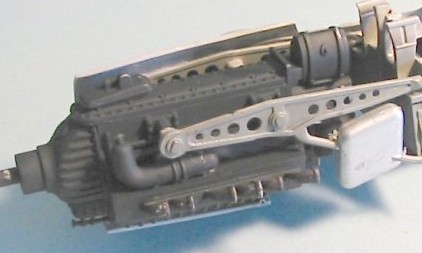 scratchbuilding the
interior detail that would then be needed. Since this model was going to be
displayed on its gear in a glass case out at Planes of Fame, the engine was
painted black. I did some detail painting to the various parts that are
visible through the gear well, following the instructions from the Hasegawa
1/32 Dora-9 kit (which are more accurate). I also realized that this kit
does not have all the plumbing associated with the engine that is very
visible in the wheel well, unlike the Hasegawa kit which provides
everything one needs. These pipes could be scratchbuilt and fitted where
they should be, and if this model was ever going to be observed while
upside-down, I would have done so.
scratchbuilding the
interior detail that would then be needed. Since this model was going to be
displayed on its gear in a glass case out at Planes of Fame, the engine was
painted black. I did some detail painting to the various parts that are
visible through the gear well, following the instructions from the Hasegawa
1/32 Dora-9 kit (which are more accurate). I also realized that this kit
does not have all the plumbing associated with the engine that is very
visible in the wheel well, unlike the Hasegawa kit which provides
everything one needs. These pipes could be scratchbuilt and fitted where
they should be, and if this model was ever going to be observed while
upside-down, I would have done so.
Overall, the engine is accurate and a good basic bit to start with if one
wants to open up the model. I think the reason the plumbing is missing
from the engine is that Trumpeter originally made the mistake of planning
the kit with a fully-enclosed gear well,
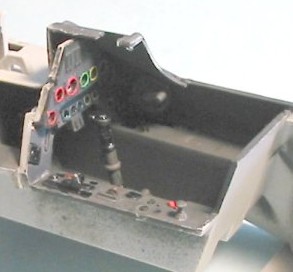 which they
“corrected” by taking out the “roof” inside the fuselage area.
Unfortunately, they left the forward “wall” of the wheel well in that area
- which a modeler has to cut away to make a correct wheel well. Out of the
box, with that wall in the way, it is difficult to fit the plumbing, which
is why I think they didn’t do it.
which they
“corrected” by taking out the “roof” inside the fuselage area.
Unfortunately, they left the forward “wall” of the wheel well in that area
- which a modeler has to cut away to make a correct wheel well. Out of the
box, with that wall in the way, it is difficult to fit the plumbing, which
is why I think they didn’t do it.
I
then went on to the cockpit. The Focke-Wulf 190 cockpit is quite clean to
begin with, and what is presented in the kit is mostly “good enough”, with
the exception of the seat. When the model is complete, the seat is the
most-visible part of the cockpit, and this kit-supplied seat is barely
adequate. Strangely, there is no provision for the seat belts; usually
Trumpeter provides photo-etch buckles and such, but they aren’t here. No
aftermarket company has yet provided 1/24 scale Luftwaffe seat belts. I
think it might be possible to get away with using the Cutting Edge 1/32
posable resin seat belts - which I think are a bit big in their scale - but
I didn’t have any to try that theory out with. Given the ultimate
destination of this model, I decided to close the canopy and not bother
with seatbelts. 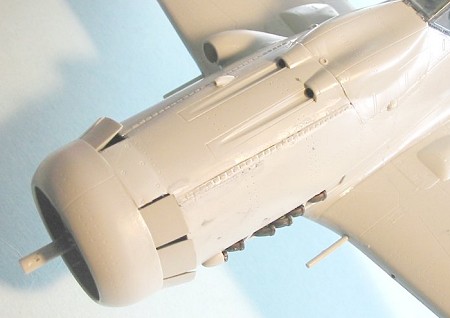
The fuselage is incorrect in that the hinge line of the forward cowling side panels is curved, rather than straight as it should be. I fixed this by cutting out a section of the panel, so that I could bend down the piano-hinge to be straight, then filling and sanding smooth the resulting gap. I then glued some sheet plastic to the upper cowling part and sanded it to the proper straight-line shape.
With the engine and cockpit areas painted and assembled, I assembled the fuselage. As I was doing this, I discovered that the tail wheel will not be in the correct fully-extended position if you attach it where the attachment points are. I ended up gluing in the tail wheel with cyanoacrylate glue to properly position it before gluing the fuselage halves together. The fuselage halves fit well, and I only needed to put some cyanoacrylate glue into the centerline seam and then carefully sand it smooth when dry, and I did not lose any of the engraved rivet detail along the seam.
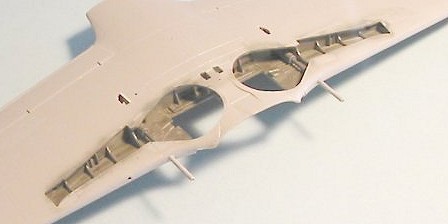 The wings were
next. The cannons bear no resemblance to any MG151 I’ve ever seen, but
since there is once again no way to open up the gun bay this doesn’t
matter. I considered making the canvas boot with Kleenex and white glue
but then remembered no one is ever going to see the underside of this model
once it’s finished so didn’t, but you might want to consider that. I did
take the time to open up the shell ejection chutes on the lower wing
surface, which are only engraved lines on the kit, before proceeding
further. The kit instructions would have you glue in the upper part of the
landing gear leg at this time, but you do not need to do so. I left mine
off and later had no trouble jimmying it into position. While this
connection may be “correct” as far as the real gear was, the result is a
very weak joint that needs a lot of reinforcement with cyanoacrylate glue
to enable to gear to support the model, unlike the nice solid connection
Hasegawa provides. (More on this blankety-blank landing gear later.)
The wings were
next. The cannons bear no resemblance to any MG151 I’ve ever seen, but
since there is once again no way to open up the gun bay this doesn’t
matter. I considered making the canvas boot with Kleenex and white glue
but then remembered no one is ever going to see the underside of this model
once it’s finished so didn’t, but you might want to consider that. I did
take the time to open up the shell ejection chutes on the lower wing
surface, which are only engraved lines on the kit, before proceeding
further. The kit instructions would have you glue in the upper part of the
landing gear leg at this time, but you do not need to do so. I left mine
off and later had no trouble jimmying it into position. While this
connection may be “correct” as far as the real gear was, the result is a
very weak joint that needs a lot of reinforcement with cyanoacrylate glue
to enable to gear to support the model, unlike the nice solid connection
Hasegawa provides. (More on this blankety-blank landing gear later.)
Another reviewer had expressed fear that the wing would have trouble maintaining its dihedral without a separate spar. This is not a problem. The gear well is also a spar, in that it is strong enough and in the right shape to hold the wings at the correct dihedral. Also, the forward wall of the flap well when glued together acts as a spar. That same reviewer was also worried that the leading edge of the wing would be noticeably flat, but this was also not a problem, since sanding the leading edge seam allows you to take care of any shape problem that might exist there - and you do have to fill that seam and sand it smooth.
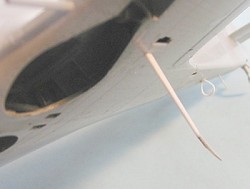 The wing
attaches easily to the fuselage and I did not need any seam-filler along
the upper-wing-to-fuselage joint, and only needed a little cyanoacrylate
glue in the seam where the rear part of the lower wing fits to the rear
fuselage.
The wing
attaches easily to the fuselage and I did not need any seam-filler along
the upper-wing-to-fuselage joint, and only needed a little cyanoacrylate
glue in the seam where the rear part of the lower wing fits to the rear
fuselage.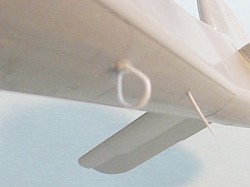
The inside of the main gear doors looks like no Fw-190 ever made. I sanded off all this detail and scratchbuilt the interior detail using Evergreen sheet and basing it on the gear door interior of a DML kit.
I also had to scratchbuild a DF loop and Morane antenna since what is provided in the kit is both too small and doesn’t look like anything ever carried on an Fw-190 of any variety.
Overall, assembly of the kit is easy. Fortunately, the mistakes that exist in the parts are easily fixable with “some modeling skill required.”
| COLORS & MARKINGS |
Painting:
The best guesses for how Theo Nibel’s Dora-9 was painted are that it had RLM82 and RLM83 dark and light green upper surfaces, lower surfaces in RLM76 grey-blue, and the rudder and lower cowling panels and lower part of the radiator cowling in RLM04 yellow.
I used Xtracrylix paints for this. Since I didn’t have the RLM82 and RLM83 colors, I substituted British Dark Green for RLM83 Dunkelgrun - since the two colors are frequently compared - and used US Medium Green with a bit of yellow added in to create RLM82 Lightgrun. I first painted the yellow areas, allowed the paint to cure overnight then masked it off. It is very important to allow Xtracrylix paints to cure fully before masking over them, or you risk pulling off paint when you pull up the making tape, even if you lose low-tack drafting tape (and yes, I did indeed learn this the hard way).
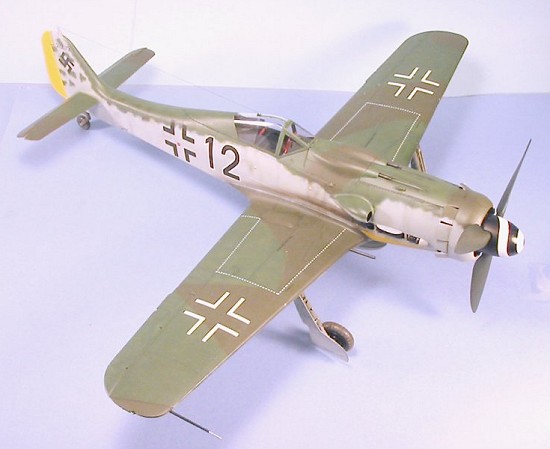 I then painted
the lower surfaces with RLM76, adding in some light grey afterwards and
going over panels since on such a large model it is crucial not to have
huge monochromatic surfaces. I let this dry to the touch - which takes
about an hour or so with this paint - then freehanded the upper colors,
adding in some lighter green to highlight panels here, too. The prop hub
and wheel hubs were painted with Tamiya X-18 Semi-gloss Black, while the
Propeller was painted with Xtracrylix RLM70
Schwarzgrun.
I then painted
the lower surfaces with RLM76, adding in some light grey afterwards and
going over panels since on such a large model it is crucial not to have
huge monochromatic surfaces. I let this dry to the touch - which takes
about an hour or so with this paint - then freehanded the upper colors,
adding in some lighter green to highlight panels here, too. The prop hub
and wheel hubs were painted with Tamiya X-18 Semi-gloss Black, while the
Propeller was painted with Xtracrylix RLM70
Schwarzgrun.
After letting the paint cure for 24 hours, I applied a coat of Future. The model being so big, I applied a pretty heavy coat of Future, and this took another 24 hours to dry to the touch because it interacted with the Xtracrylix paint and another 12 to cure fully. I think the next time I use Xtracrylix on a large model, I will use a lacquer-base varnish like Testor’s Glosscote, which should dry hard within a few hours without interacting with the Xtracrylix.
Final Assembly:
I decided to attach the landing gear at this point. The main gear is supposed to have a spring inside the oleo. I tested this and it was very apparent very quickly that this would be too weak to support the model without the spring eventually compressing to the point the model would sink to where the gear doors held it up. I therefore glued the gear legs so they were immovable. Interestingly, I found out that when the oleo was extended to the point where the scissors was extended at the same angles it is in the correctly-designed Hasegawa kit, it is 1/8 inch too short to fit withe the gear doors, which will be scraping the ground. I ended up cutting off 1/8 inch from the top of the gear doors, and they fit fine when I attached the wheels.
I then attached the drop tank - which is not correctly shaped with the flat area in the lower rear quadrant - and the propeller.
Decals:
There aren’t any aftermarket 1/24 Fw-190D-9 decals available right now. Jerry Crandall has told me that Eagle Editions will be printing 1/24 versions of all their Fw-190D-9 decals; however, these will not be available until late January at the earliest, due to the fact that the Micro-Scale factory has had to shut down for five weeks to institute structural repairs to the building. I am sure that the other aftermarket companies will also be enlarging their Fw-190D-9 sheets in coming months.
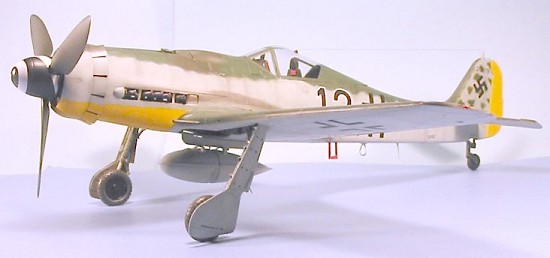 One reason I
had chosen to do Nibel’s airplane was because the kit decals include a
proper-sized “Black 12.” This does not have the white border that Nibel’s
did, but I trimmed each number with the proper border, then cut out white
decal sheet in the correct size and shape, and applied these in the
standard “two-color/two-step” process. I used the kit decals for the
national insignia and stenciling, which presented no problems.
One reason I
had chosen to do Nibel’s airplane was because the kit decals include a
proper-sized “Black 12.” This does not have the white border that Nibel’s
did, but I trimmed each number with the proper border, then cut out white
decal sheet in the correct size and shape, and applied these in the
standard “two-color/two-step” process. I used the kit decals for the
national insignia and stenciling, which presented no problems.
When the decals were set, I airbrushed some Testor’s ModelMaster Metalizer Sealer over them, to avoid any more “Future” problems.
Final Finish:
I applied exhaust staining on the fuselage per the photos taken of Nibel’s airplane after the crash (but without the spilled and burned areas), using Tamiya “Smoke.” I then applied several coats of Testor’s Dullcote to get the model down to a satin/flat finish. Nibel’s airplane was likely not more than six weeks old at the time of its loss, and had not been flown a lot prior to the Bodenplatte mission, so I left it free of dings and such.
| CONCLUSIONS |
This is the best of the Trumpeter 1/24 kits so far released. I say that because, while it has all the mistakes mentioned above, these mistakes are not fatal - unlike the designed-into-the-structure mistakes of the P-51D, the Zero, and the Spitfire V. When you get done with these fixes outlined here, the result is a model that is “right” as regards shape and outline - unlike the others it is not unfixably wrong.
To me, this big kit provides good “source material” to the modeler who wants to build a super-detailed recreation of the Dora-9 and is willing to do the scratch-building and detailing necessary. It’s likely to be a one-time-only acquisition. For those of us who want to do Dora-9s for their markings and look, and who don’t have a hangar in the back yard to store more than one of these things, the Hasegawa 1/32 kit is one-third the price and completely “accurate enough” right out of the box.
The bottom line is, I opened the box expecting a disaster, and didn’t find one. This really is Trumpeter’s best big model to date; the problems I found are easily fixable, and even if you don’t open it up and super-detail it, I can promise you that people will definitely be taken aback when they see this Big Dora completed - when I carried it across the tarmac out at Planes of Fame, Steve Hinton put down his work on the Hawk 75A-1 they’ve restored and said “Whoa! That’s nice!” ‘Nuff said.
November 2004
| REFERENCES |
(Editor's input) Those who want to find out more about Operation Bodenplatte need to pick up the book Bodenplatte, by Hikoki. This book covers most of what Tom mentioned in his fine historical perspective, and much more. It has the operations of every Luftwaffe unit that participated and has to be THE source for information on this topic.
Copyright ModelingMadness.com. All rights reserved. No reproduction in part or in whole without express permission.
If you would like your product reviewed fairly and fairly quickly, please contact the editor or see other details in the Note to Contributors.